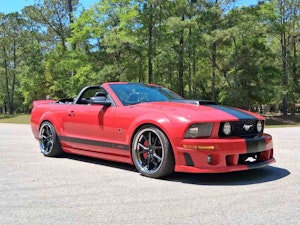Media | Articles
At Mitsubishi in the 1990s, a convertible 3000GT was no simple thing
An Original Equipment Manufacturer (OEM) is generally defined as an automaker or a company that supplies parts to an automaker for a final product. This definition, perhaps, should in honorary instances be extended include engineering companies like Cars and Concepts and the American Sunroof Corporation (ASC).
Cars and Concepts was involved in re-introducing the Mustang convertible in 1983, but the ASC went even further: With Mitsubishi’s blessing, ASC engineered and installed a retractable hardtop for the Japanese automaker’s flagship 3000GT sports coupe, creating the 1995-96 model year 3000GT Spyder.
Back in the day, Motorweek got an insider’s view of how California-based ASC took these special ordered, uniquely prepared 3000GTs from the factory in Nagoya, Japan and transformed them into the retractable hardtop Spyder models. This was not a simple sunroof swap; ASC’s three-zone process includes adding significant structural rigidity to the unibody before cutting the roof and adding a bespoke folding hardtop design. Designing and engineering this system was a major undertaking that included developing unique components and harnessing untold hours of skilled labor to finally turn out a complete 3000GT Spyder.
Much like the Ford Skyliner that came before it, the Mitsubishi 3000GT Spyder (in either SL or hotter VR-4 trim) was a byproduct of contemporary tastes and market conditions. Japanese sports cars were experiencing a resurgence in the 1990s, and from the NSX to the Lexus LS400, there was an ambitious, full-on product assault on the American market.
Over time, however, automakers began to increasingly move operations of this sort in-house. This trend, combined with ASC founder Heinz Prechter’s death in 2001, led to ASC’s downturn and eventual demise in 2017. The last vestige of what was once ASC’s empire is now an an accessory and trim outfit in San Diego ostensibly performing much less comprehensive work, including being an “authorized installation center” for Webasto branded sunroofs. (The painful irony should be noted here, seeing as ASC sold thousands of its own drop-in moonroofs to luxury car dealers in the Texas region alone.)
Marketplace
Buy and sell classics with confidence
The 3000GT Spyder wasn’t cheap, which was a common weak point for this era’s technologically advanced Japanese sports cars, including the famous Mark IV Toyota Supra. The Spyder VR-4’s $68,766 asking price in Motorweek’s review was just grand cheaper than a baseline Mercedes SL320 roadster, and the twin-turbo Mitsubishi would eat the Mercedes for breakfast.
Of course, in the long run, Mitsubishi’s 3000GT has not set the collector world on fire nearly to the extent of the Supra Turbo. If they ever do, there’s a case to be made for the Spyder VR-4 leading the charge: limited production (1034 units over two years), sports cars charms, and mechanized roof appeal are evidence of a proud and confident Mitsubishi very different from the company we know today.
Don’t believe me? Just look at how well slab-sided Lincoln Continental drop tops of the 1960s are regarded today, relative to how few people actually wanted them back in period.










